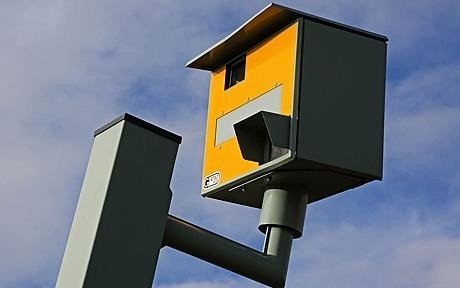
High surveillance video that time you from point to point. These are designed to prevent motorists from braking at the GATSO camera and speeding up later as they calculate your average speed between points, up to a mile and if you’re over the limit, you’re booked.
These are normally mounted on bridges or easily identifiable gantries and can be spotted by the infra red detectors either side of the camera.
These cameras are currently undetectable by standard radar detectors but will be by GPS, satellite tracking system, such as the Origin Blue i.
Lancashire became the latest county in the UK to announce on TV a massive Speed Camera investment program. With 60 cameras currently, the number is set to rise to 300 over the next two years. Police will also be using long range radar out of mobile vans to trap speeding motorists.
Police will use local media to tell motorists where they will be operating mobile speed cameras. The Department of Transport is also advising 15 forces to post details on the internet.
Roaming units are designed to catch speeding drivers who escape prosecution by slowing down at fixed camera points.
The recommendations are being only made to forces which keep a larger percentage of revenue from speeding fines.
The RAC says telling drivers will be a deterrent and save lives, but motorists in some counties will not receive the information.
Department of Transport guidelines says policemen on the roadside must wear fluorescent jackets and be clearly visible, as must their patrol cars. Police are authorised to use the cameras where there have been four or more speed-related deaths or serious injuries in three years.
The cameras must be moved elsewhere if 30% of the traffic is not breaking the limit, says The Daily Telegraph.
Speed camera plan ‘may cause deaths’
Government plans to introduce more high visibility speed cameras may actually increase deaths rather than improve road safety, experts have warned.
Ministers announced plans last year to paint speed cameras yellow to ensure they could be seen by motorists and to ban warning signs on roads where there were no cameras.
The policy is aimed at cutting road accidents amid fears that many drivers brake suddenly when they see or are warned of speed cameras.
When people see cameras ahead they do slow down
Department of Transport spokesman However, public health specialist Paul Pilkington has warned there is no evidence to support the government’s claims.
Writing in the latest issue of the British Medical Journal, he said hidden cameras had been shown to reduce deaths and injury on roads.
‘No evidence
Mr Pilkington, who works in Bristol, suggested high visibility cameras would not be as effective.
He said drivers would simply drive slowly in areas with cameras and accelerate in those areas without the deterrent.
“These measures seem designed to placate the angry minority of motorists who believe that drivers should be warned about impending cameras, giving them the chance to slow down.
“But this view is not based on evidence of health benefits. Hidden cameras are associated with net falls in speeds, crashes and casualties when compared with visible ones.”
He added: “The introduction of high visibility speed cameras is a mistake. We need evidence that they are more effective than hidden cameras.”
But a spokesman for the Department of Transport rejected the claim. He said cameras were placed in areas where motorists were most at risk of having an accident.
He said: “Cameras are situated in areas where there is a history of accidents. When people see cameras ahead they do slow down. Slowing down at dangerous stretches of a road is very good.”
He added: “Making the cameras more visible gives drivers enough distance to slow down and takes away the need for sudden braking. Gradual braking is much better than sudden braking.”
In other research, published in the BMJ, doctors warned that driver air bags offered relatively little benefit to motorists compared to seat belts.
They found that seat belts provide much more effective protection, reducing the risk of death by 65%. This compares with air bags which, they said, were associated with an 8% reduction in risk.
A study by Canadian doctors also showed that seat belts provided effective protection to children even though they are usually designed to be used by adults.
Speed camera hotspots revealed
The number of speed cameras could triple
Motorists traveling on a Staffordshire road are being monitored by almost four speed cameras every mile, according to a survey.
The section of the A34 between Bloxwich and Cannock is dotted with 12 cameras in less than three and half miles.
Its rate of 3.8 cameras per mile beats a stretch of road in Watford which has 2.8 per mile but is behind the UK’s highest of 5.8 per mile in Camarthenshire, south Wales.
The concentration is described as “extravagant” by the Automobile Association but they said motorists driving within the speed limit had nothing to fear from the cameras.
Speed camera hotspots:
- A34, Bloxwich, 12 cameras in 3.2 miles, 3.8 per mile
- A411, Watford, 13 cameras in 4.2 miles, 3.1 per mile
- M25, Surrey, 48 cameras in 16 miles, 3 per mile
- Carmarthenshire, 7 cameras in 1.2 miles, 5.8 per mile
The survey was conducted by Morpheous, which manufactures an in-car speed camera detector.
Police have supported siting cameras for road safety reasons.
But Simon Wooding, spokesman for the AA in the Midlands, said: “Four per mile is quite extravagant, I only hope people are slowing down and these cameras are achieving their purpose.
“It’s a shame people can’t take their foot off the accelerator and need technology to slow them down.
“If speed restrictions can’t be enforced, or people refuse to adhere to them, one of the most effective means of slowing motorists down is speed cameras.”
Inspector Mark Riley, of Staffordshire Police, said: “If there are traffic safety issues then the police support the siting of speed cameras.”
The number of cameras on the roads in England and Wales could triple over the next few years, from 4,000 to 12,000, as more police forces join the government’s “cash for cameras” scheme.
Under the National Safety Camera Initiative, police forces are allowed to keep part of the revenue from fines for speeding to use for traffic safety.
Last week another 10 forces joined the scheme bringing the total to 25 out of the 43 police forces in England and Wales.















Facebook Conversations